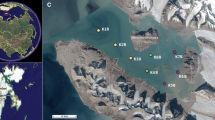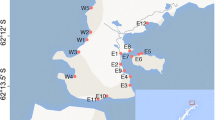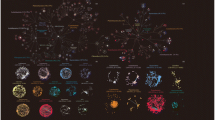Abstract
Community structure of sediment bacteria in the Everglades freshwater marsh, fringing mangrove forest, and Florida Bay seagrass meadows were described based on polymerase chain reaction-denaturing gradient gel electrophoresis (PCR-DGGE) patterns of 16S rRNA gene fragments and by sequencing analysis of DGGE bands. The DGGE patterns were correlated with the environmental variables by means of canonical correspondence analysis. There was no significant trend in the Shannon–Weiner index among the sediment samples along the salinity gradient. However, cluster analysis based on DGGE patterns revealed that the bacterial community structure differed according to sites. Not only were these salinity/vegetation regions distinct but the sediment bacteria communities were consistently different along the gradient from freshwater marsh, mangrove forest, eastern-central Florida Bay, and western Florida Bay. Actinobacteria- and Bacteroidetes/Chlorobi-like DNA sequences were amplified throughout all sampling sites. More Chloroflexi and members of candidate division WS3 were found in freshwater marsh and mangrove forest sites than in seagrass sites. The appearance of candidate division OP8-like DNA sequences in mangrove sites distinguished these communities from those of freshwater marsh. The seagrass sites were characterized by reduced presence of bands belonging to Chloroflexi with increased presence of those bands related to Cyanobacteria, γ-Proteobacteria, Spirochetes, and Planctomycetes. This included the sulfate-reducing bacteria, which are prevalent in marine environments. Clearly, bacterial communities in the sediment were different along the gradient, which can be explained mainly by the differences in salinity and total phosphorus.





Similar content being viewed by others
References
Begon M, Harper JL, Townsend CR (1990) Ecology. Individuals, populations and communities, 2nd edn. Blackwell Scientific, Cambridge
Bissett A, Burke C, Cook PLM, Bowman JP (2007) Bacterial community shifts in organically perturbed sediments. Environ Microbiol 9:46–60
Bordalo AA (1993) Effects of salinity on bacterioplankton, field and microcosm experiments. J Appl Bacteriol 75:393–398
Bossio DA, Girvan MS, Verchot L, Bullimore J, Borelli T, Albrecht A, Scow KW, Ball AS, Pretty JN, Osborn AM (2005) Soil microbial community response to land use change in an agricultural landscape of western Kenya. Microb Ecol 49:50–62
Bowman JP, McCammon SA, Gibson JAE, Robertson L, Nichols PD (2003) Prokaryotic activity and community structure in Antarctic continental shelf sediment. Appl Environ Microbiol 69:2448–2462
Bowman JP, McCuaig RD (2003) Biodiversity, structural shifts, and biogeography of prokaryotes within Antarctic continental shelf sediment. Appl Environ Microbiol 69:2463–2483
Boyer JN, Fourqurean JW, Jones RD (1997) Spatial characterization of water quality in Florida Bay and Whitewater Bay by principal component and cluster analyses: zones of similar influence (ZSI). Estuaries 20:743–758
Bradford D, Hugenholtz P, Seviour EM, Cunningham MA, Stratton H, Seviour RJ, Blackall LL (1996) 16S rRNA analysis of isolates obtained from gram-negative, filamentous bacteria micromanipulated from activated sludge. Syst Appl Microbiol 19:334–343
Brenhard AE, Colbert D, McManus J, Field KG (2005) Microbial community dynamics based on 16S rRNA gene profiles in a Pacific northwest estuary and its tributaries. FEMS Microbiol Ecol 52:115–128
Cammen LM (1982) Effect of particle size on organic content and microbial abundance within four marine sediments. Mar Ecol Prog Ser 9:273–280
Castle D, Kirchman DL (2004) Composition of estuarine bacterial communities assessed by denaturing gradient gel electrophoresis and fluorescence in situ hybridization. Limnol Oceanogr Methods 2:303–314
Castro H, Reddy KR, Ogram A (2002) Composition and function of sulfate-reducing prokaryotes in eutrophic and pristine areas of the Florida Everglades. Appl Environ Microbiol 65:6129–6137
Childers DL (2006) A synthesis of long-term research by the Florida Coastal Everglades LTER Program. Hydrobiologia 569:531–544
Childers DL, Doren RF, Jones R, Noe GB, Rugge M, Scinto LJ (2003) Decadal change in vegetation and soil phosphorus pattern across the Everglades landscape. J Environ Qual 32:344–362
Colquhoun JA, Heald SC, Li L, Tamaoka J, Kato C, Horikoshi K, Bull AT (1998) Taxonomy and biotransformation activities of some deep-sea actinomycetes. Extremophiles 2:269–277
Crump BC, Hopkinson CS, Sogin ML, Hobbie JE (2004) Microbial biogeography along an estuarine salinity gradient: combined influences of bacterial growth and residence time. Appl Environ Microbiol 70:1494–1505
Danovaro R, Manini E, Dell’Anno A (2002) Higher abundance of bacteria than of viruses in deep Mediterranean sediments. Appl Environ Microbiol 68:1468–1472
Dufresne A, Salanoubat M, Partensky F, Artiguenave F, Axmann IM, Barbe V, Duprat S, Galperin MY, Koonin EV, Le Gall F, Makarova KS, Ostrowski M, Oztas S, Robert C, Rogozin IB, Scanlan DJ, Tandeau de Marsac N, Weissenbach J, Wincker P, Wolf YI, Hess WR (2003) Genome sequence of the cyanobacterium Prochlorococcus marinus SS120, a nearly minimal oxyphototrophic genome. Proc Natl Acad Sci 100:10020–10025
Feris KP, Ramsey PW, Frazar C, Rillig M, Moore JN, Gannon JE, Holben WE (2004) Seasonal dynamics of shallow-hyporheic-zone microbial community structure along a heavy-metal contamination gradient. Appl Environ Microbiol 70:2323–2331
Fourqurean JW, Jones RD, Zieman JC (1993) Processes influencing water column nutrient characteristics and phosphorus limitation of phytoplankton biomass in Florida Bay, FL, USA: inferences from spatial distributions. Estuar Coast Shelf Sci 36:295–314
Freitag TE, Chang L, Prosser JI (2006) Changes in the community structure and activity of betaproteobacterial ammonia-oxidizing sediment bacteria along a freshwater–marine gradient. Environ Microbiol 8:684–696
Giovannoni SJ, Rappé MS, Vergin KL, Adair NL (1996) 16S rRNA genes reveal stratified open ocean bacterioplankton populations related to the green non-sulfur bacteria. Proc Natl Acad Sci 93:7979–7984
Girvan MS, Bullimore J, Pretty JN, Osborn M, Ball AS (2003) Soil type is the primary determinant of the composition of the total and active bacterial communities in arable soils. Appl Environ Microbiol 69:1800–1809
Gomes NCM, Borges LR, Paranhos R, Pinto FN, Mendonça-Hagler LCS, Smalla K (2008) Exploring the diversity of bacterial communities in sediments of urban mangrove forests. FEMS Microbiol Ecol 66:96–109
Hood GM (2008) PopTools: version 3.0.6. Available on the internet. URL: http://www.cse.csiro.au/poptools/
Hugenholtz P, Goebel BM, Pace NR (1998) Minireview: impact of culture-independent studies on the emerging phylogenetic view of bacterial diversity. J Bacteriol 180:4765–4774
Hugenholtz P, Pitulle C, Hershberger KL, Pace NR (1998) Novel division level bacterial diversity in a Yellowstone hot spring. J Bacteriol 180:366–376
Ikenaga M, Asakawa S, Muraoka Y, Kimura M (2003) Bacterial communities associated with nodal roots of rice plants along with the growth stages, estimation by PCR-DGGE and sequence analyses. Soil Sc Plant Nutr 49:591–602
Jensen PR, Dwight R, Fenical W (1991) Distribution of actinomycetes in near-shore tropical marine sediments. Appl Environ Microbiol 57:1102–1108
Jensen SI, Kühl M, Priemé A (2007) Different bacterial communities associated with the roots and bulk sediment of the seagrass Zostera marina. FEMS Microbiol Ecol 62:108–117
Jukes TH, Cantor CR (1969) Evolution of protein molecules. In: Munro HM (ed) Mammalian protein metabolism. Academic, New York, pp 21–132
Kelso BHL, Smith RV, Laughlin RJ, Lennox SD (1997) Dissimilatory nitrate reduction in anaerobic sediments leading to river nitrite accumulation. Appl Environ Microbiol 63:4679–4685
Koizumi Y, Kojima H, Oguri K, Kitazato H, Fukui M (2004) Vertical and temporal shifts in microbial communities in the water column and sediment of saline meromictic lake Kaiike (Japan), as determined by a 16S rDNA-based analysis, and related to physicochemical gradients. Environ Microbiol 6:622–637
Ludwig W, Strunk O, Klugbauer S, Klugbauer N, Weizenegger M, Neumaier J, Bachleitner M, Schleifer KH (1998) Bacterial phylogeny based on comparative sequence analysis. Electrophoresis 19:554–568
Luo HF, Qi HY, Zhang HX (2004) Assessment of the bacterial diversity un fenvalerate-treated soil. World J Microbiol Biotechnol 20:509–515
McIvor CC, Ley JA, Bjork RD (1994) Changes in freshwater inflow from the Everglades to Florida Bay including effects on biota and biotic processes; a review. In: Davis SM, Ogden JC (eds) Everglades, the ecosystem and its restoration. St. Lucie, Delray Beach, pp 117–146
Methe BA, Hiorns WD, Zehr JP (1998) Contracts between marine and freshwater bacterial community composition: analysis of communities in lake George and six other Adirondack lakes. Limnol Oceanog 43:368–374
Mincer TJ, Jensen PR, Kauffman CA, Fenical W (2002) Widespread and persistent populations of a major new marine actinomycete taxon in ocean sediments. Appl Environ Microbiol 68:5005–5011
Montagna PA (1982) Sampling design and enumeration statistics for bacteria extracted from marine sediments. Appl Environ Microbiol 43:1366–1372
Moran MA, Rutherford LT, Hodson RE (1995) Evidence for indigenous Streptomyces populations in a marine environment determined with a 16S rRNA probe. Appl Environ Microbiol 61:3695–3700
Muyzer G, de Waal EC, Uitterlinden AG (1993) Profiling of complex microbial populations by denaturing gradient gel electrophoresis analysis of polymerase chain reaction-amplified genes coding for 16S rRNA. Appl Environ Microbiol 59:695–700
Nealson KH (1997) Sediment bacteria: who’s there, what are they doing, and what’s new? Annu Rev Earth Planet Sci 25:403–434
Piza FF, Prado PI, Manfio GP (2004) Investigation of bacterial diversity in Brazilian tropical estuarine sediments reveals high actinobacterial diversity. Antonie Leeuwenhoek 86:317–328
Powell SM, Bowman JP, Snape I, Stark JS (2003) Microbial community variation in pristine and polluted nearshore Antarctic sediments. FEMS Microbiol Ecol 45:135–145
Prieur D, Troussellier M, Romana A, Chamroux S, Mevel G, Baleux B (1987) Evolution of bacterial communities in the Gironde estuary (France) according to a salinity gradient. Estuarine Coastal Shelf Sci 24:95–108
Purdy KJ, Embley TM, Nedwell DB (2002) The distribution and activity of sulphate reducing bacteria in estuarine and coastal marine sediments. Antonie van Leeuwenhoek 81:181–187
Randolph MC, Kristin AP (2006) Variation in soil phosphorus, sulfur, and iron pools among south Florida wetlands. Hydrobiologia 569:63–70
Ranjard L, Poly F, Nazaret S (2000) Mini-review: monitoring complex bacterial communities using culture-independent molecular techniques: application to soil environment. Res Microbiol 151:167–177
Rubin MA, Leff LG (2007) Nutrients and other abiotic factors affecting bacterial communities in an Ohio River (USA). Microb Ecol 54:374–383
Rudnick D, Madden D, Kelly S, Bennett R, Cunniff K (2006) Report on algae blooms in eastern Florida Bay and southern Biscayne Bay. Coastal Ecosystems Division South Florida Water Management Distinct
Sahm K, MacGregor BJ, Jørgensen BB, Stahl DA (1999) Sulfate-reducing bacterial quantified by rRNA slot-blot hybridization in a coastal marine sediment. Environ Microbiol 1:65–74
Sakami T (2008) Seasonal and spatial variation of bacterial community structure in river-mouth areas of Gokasho Bay, Japan. Microbes Environ. 23:277–284
Scanlan DJ (2003) Physiological diversity and niche adaptation in marine Synechococcus. Adv Microb Physiol 47:1–64
Schmidt JL, Deming JW, Jumars PA, Keil RG (1998) Constancy of bacterial abundance in surficial marine sediments. Limnol Oceanogr 43:976–982
Sekiguchi H, Watanabe M, Nakahara T, Xu B, Uchiyama H (2002) Succession of bacterial communities structure along the Changjiang River determined by denaturing gradient gel electrophoresis and clone library analysis. Appl Environ Microbiol 68:5142–5150
Siddique T, Okeke BC, Zhang Y, Arshad M, Han SK, Frankenberger WT Jr (2005) Bacterial diversity in selenium reduction of agricultural drainage water amended with rice straw. J Environ Qual 34:217–226
Solorzano L, Sharp JH (1980) Determination of total dissolved nitrogen in natural waters. Limnol Oceanogr 25:75 l–754
Soltwedel T, Vopel K (2001) Bacterial abundance and biomass in response to organism-generated habitat heterogeneity in deep-sea sediments. Mar Ecol Prog Ser 319:291–298
Stach JEM, Maldonado LA, Masson DG, Ward AC, Goodfellow M, Bull AT (2003) Statistical approaches for estimating actinobacterial diversity in marine sediments. Appl Environ Microbiol 69:6189–6200
Ter Braak CJF (1990) Update notes: CANOCO version 3.10. Agricultural Mathematics Group, Wageningen
Ter Braak CJF, Smilauer P (1998) Canoco reference manual and user's guide to Canoco for Windows: software for canonical community ordination (version 4). Microcomputer Power, Ithaca, p 352
Thompson JD, Gibson TJ, Plewniak F, Jeanmougin F, Higgins DG (1997) The ClustalX windows interface: flexible strategies for multiple sequence alignment aided by quality analysis tools. Nucleic Acids Res 24:4876–4882
Torsvik V, Øvreås L, Thingstad TF (2002) Prokaryotic diversity—magnitude, dynamics, and controlling factors. Science 296:1064–1066
Urakawa H, Kita-Tsukamoto K, Ohwada K (1999) Microbial diversity in marine sediments from Sagami bay and Tokyo bay, Japan, as determined by 16S rRNA gene analysis. Microbiol 145:3305–3315
Uz I, Chauhan A, Ogram AV (2007) Cellulolytic, fermentative, and methanogenic guilds in benthic periphyton mats from the Florida Everglades. FEMS Microbiol Ecol 61:337–347
Valdes M, Albright LJ (1981) Survival and heterotrophic activities of Fraser river and strait of Georgia bacterioplankton within the Fraser river plume. Mar Biol 64:231–241
Vallaeys T, Topp E, Muyzer G (1997) Evaluation of denaturing gradient gel electrophoresis in the detection of 16S rDNA sequence variation in rhizobia and methanotrophs. FEMS Microbiol Ecol 24:279–285
Van de Peer Y, De Wachter R (1994) TREECON for Windows: a software package for the construction and drawing of evolutionary trees for the Microsoft Windows environment. Comput Applic Biosci 10:569–570
Wise MG, McArthur JV, Shimkets LJ (1997) Bacterial diversity of a Carolina bay as determined by 16S rRNA gene analysis: confirmation of novel taxa. Appl Environ Microbiol 63:1505–1514
Woese CR (1987) Bacterial evolution. Microbiol Rev 51:221–271
Worden AZ, Chisholm SW, Binder BJ (2000) In situ hybridization of Prochlorococcus and Synechococcus (marine Cyanobacteria) spp. with rRNA-targeted peptide nucleic acid probes. Appl Environ Microbiol 66:284–289
Wu L, Kellogg L, Devol AH, Tiedje JM, Zhou J (2008) Microarray-based characterization of microbial community functional structure and heterogeneity in marine sediments from the Gulf of Mexico. Appl Environ Microbiol 74:4516–4529
Xu P, Leff LG (2004) Longitudinal changes in the benthic bacterial community of the Mahoning River (Ohio, U.S.A.). Hydrobiologia 522:329–335
Acknowledgments
This research was supported by the National Science Foundation through the Florida Coastal Everglades Long-Term Ecological Research Program (DEB-9901514). This is contribution #448 of the Southeast Environmental Research Center at Florida International University.
Author information
Authors and Affiliations
Corresponding author
Appendix
Appendix
Rights and permissions
About this article
Cite this article
Ikenaga, M., Guevara, R., Dean, A.L. et al. Changes in Community Structure of Sediment Bacteria Along the Florida Coastal Everglades Marsh–Mangrove–Seagrass Salinity Gradient. Microb Ecol 59, 284–295 (2010). https://doi.org/10.1007/s00248-009-9572-2
Received:
Accepted:
Published:
Issue Date:
DOI: https://doi.org/10.1007/s00248-009-9572-2




